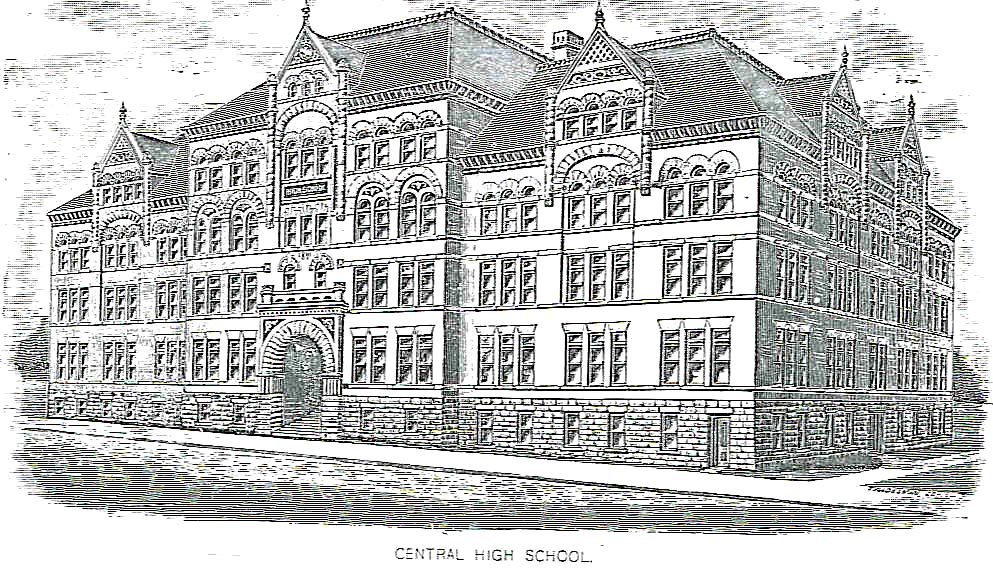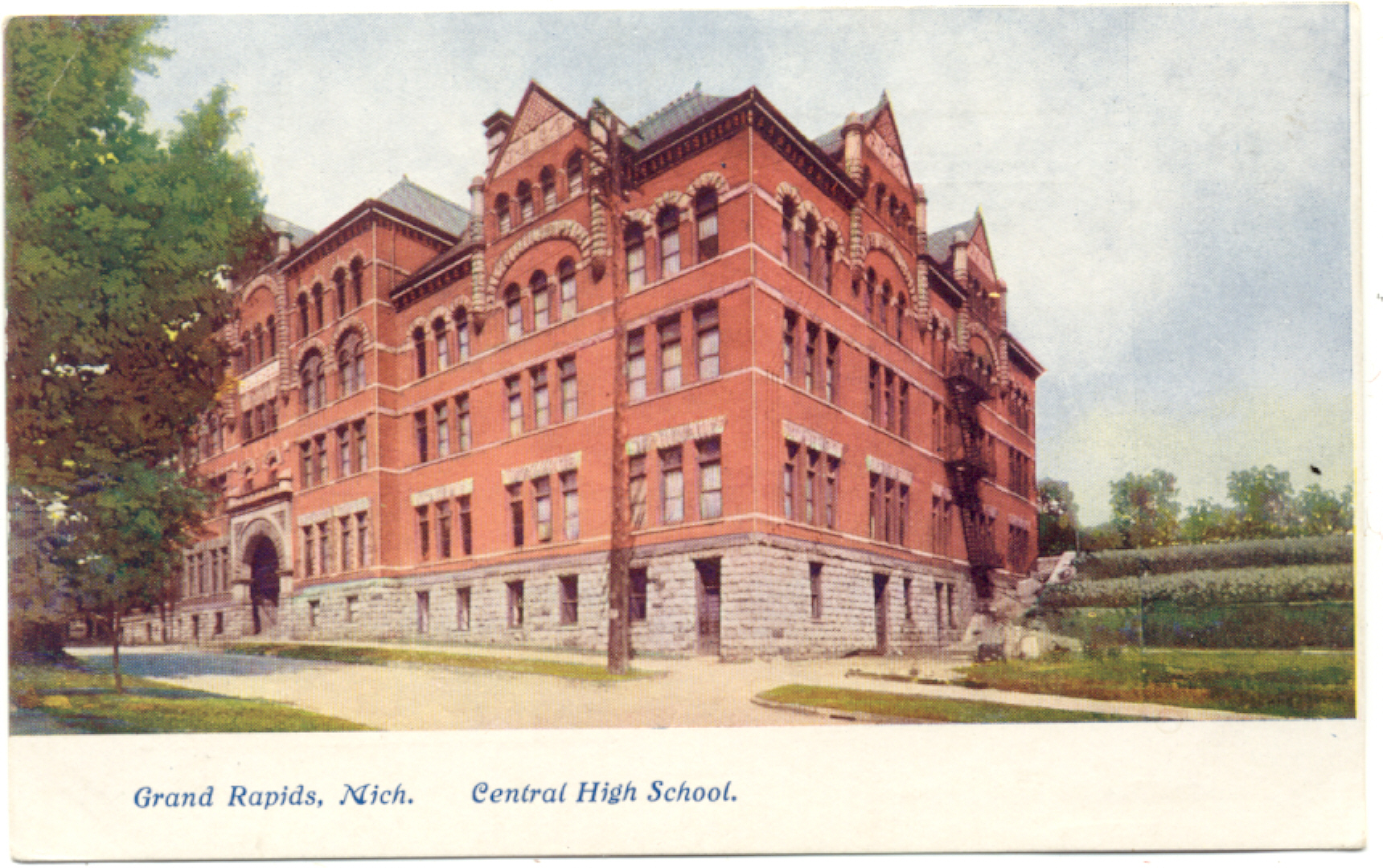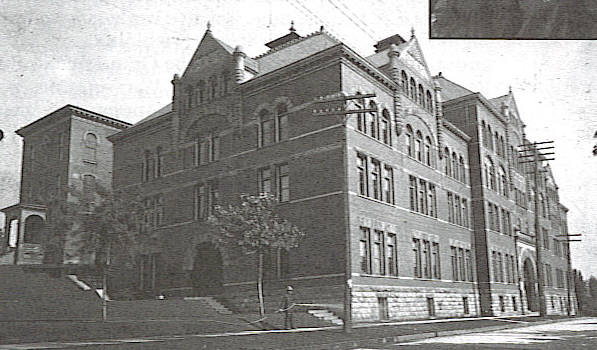
History of Central High School
Grand Rapids, Michigan

Photo of the 1891 Central High School Building
Early History of Grand Rapids Central High School, 1835-1907
|
The first school in what was to become the City of Grand Rapids was a Baptist
mission established in 1826 for the Indians. Some of the children of the white
settlers attended this school, having to cross the Grand River in canoes. The
first school for white children was started in 1835 and lasted for a brief two
months. Following this, other private schools opened, in a hotel, barn and
private homes. These were mostly small and lasted for brief periods. The first
school to open on the secondary level was established by Henry Seymour in 1842. In 1835, the first school district in what would later become the City of Grand Rapids was organized. Its territory was the area east of the river. The first teacher was hired in 1837. In 1839, the first school house was built on East Fulton opposite of Jefferson Avenue. Debate over the concept of union (graded) schools had begun in 1840 and resulted in the passage of a state law in 1843 which authorized the unionization of schools. This allowed schools to combine and to classify the students on the basis of "proficiency and advancement in learning" . The first district split in 1848 and the portion north of Newberry Street became District No. 6. This school was called Coldbrook and was located in the vicinity where East Leonard School is today. In 1849, the southern half, still called District No. 1, adopted the union principle (graded classes). However, the districts were still separate and schools were not completely graded un 1859. During this time, the west side became District No. 2 and set up its own schools using the union system. On January 8, 1849 a contract was completed for building a new school. This proved timely, because the school on Fulton burned in February. The new school was built on Ransom Avenue near Lyon Street and was made from stones taken from the river bed. It was 44 by 64 feet and had three large study rooms, six recitation rooms, a dressing room for girls, and a room for the library and school apparatus. There was an octagonal dome, covered with a tin roof which held the school bell. It was two stories with a low basement but it soon became necessary to use the basement and the earth around it was dug away and scattered over the school grounds. The first term under the new system that had been adopted was begun in the Stone Schoolhouse in November, 1849. The school was known as Union School No. 1 of the City of Grand Rapids. It was not yet a high school but offered all subjects as required by law and advanced courses as demanded. "In 1859 the state legislation passed an act specifically authorizing any district containing more than 200 children to establish a high school and vote a tax to support it." In that same year, the Grand Rapids voters approved the creation of a high school and the completion of grading the schools. The third floor of the stone school was used for the high school, the seniors being seated in the back. The first graduating class was in 1862 and consisted of thirteen girls. "The boys of ’62 were making history, not studying it. The great Civil War, which to present day pupils means little more than so many pages of United States history, was a live issue then." There was one boy in this first class, Charles W. Calkins, but he dropped out before graduation and went to war. He rose to the rank of colonel, "and almost any boy would gladly abandon scholastic for military honors." The first commencement was held at Luce’s hall, site of the present Wurzburg’s, "and it required two sessions, afternoon and evening, to properly graduate those thirteen students." Every member of the class participated in the event. Dressed in white, each girl had to read an essay to show her intelligence before receiving her diploma.
|
************************************************
The first building, the Stone School existed 1845-1867.
The second building existed 1868-1911
The third building existed 1891-


*************************************************
|
One of the outstanding citizens of Grand Rapids, Charles E. Belknap, attended this school and wrote about his experience in his book, The Yesterdays of Grand Rapids: "The first school I attended on coming to Grand Rapids was on Fountain Street hill, the High School of the town. It had three study and six recitation rooms. There was no basement to the building. It was heated by wood stoves. Drinking water was brought from a side hill spring in a pail and all the pupils drank from the same dipper. Mr. Chesebro was the principal and with rare good judgment selected the teachers who assisted him. The years in which he served were a trying time in the history of the schools. The town was growing rapidly, but no funds could be gained to build and equip buildings. The small salary of teachers was often paid by school orders, passed at the stores at a discount or in payment for merchandise at a high profit. The crowded school rooms, poorly ventilated, and heated by wood stoves, with board floors where scores of muddy boots left a trail of soil, were not a pleasant atmosphere in which to work. The old playgrounds and my old playmates, come clearly to my mind. There was only an acre of sand lot on the sand hill bluffs for play grounds and half this space was piled high with wood for the stoves. The girls managed to get in a few swings but most of the place looked like a prairie dog village, where various clans of boys dug in tunnels and made fortifications for their battles. This congestion led to some of the boys going outside the fence to the bluffs, even as far from school as the present site of Crescent Park. Here in a bunch of oak grubs, Richard Blumrich, Henry Leffingwell, and Henry Rounds tunneled through a point in the hill and felt they had a safe retreat from any hostile clan. There on noon Henry Rounds, who was mostly legs, was caught by a cave-in and only his feet left in sight. His mates began frantically pulling at the legs. A Dutchman, who owned the lot, advised them to wait while he ran to the brewery for a shovel, but the boys with bare hands succeeded in digging him out, and by the time the shovel was at hand every known way of getting sand out of a cave man and air into him, was being applied. The concept of free schools was being advanced during this time. District No. 1 claimed that its new central school was free but rate bills were still being collected with payment being based on the amount of work taken by the student. By 1860 the schools were free except the high school until 1869 when a state law finally made it mandatory for all public schools to be free. However, tuition continued to be charged for students living out of the area. As the city continued to grow, the school became cramped and overcrowded and as early as 1860 planning began for a new school. The Civil War and the unwillingness of the people prevented any immediate action to finance a new school. But eventually the school became too crowded and with the knowledge of danger due to defective walls, a new school was completed in 1868. The old stone school was torn down and the stone was sold to various citizens. The new school was built just east of the stone school and was 65 x 106 feet with 23 rooms and a seating capacity for 600 pupils. Its most outstanding feature was a tower, 137 feet high on the south west corner. The Superintendent’s office occupied the tower on the first floor, the museum on the second and a recitation room on the third. The school held three departments, Central High which included grades 9-12, Central Grammar grades 7-8 and Central Intermediate grades 5-6. Prior to the 1850 incorporation of the City of Grand Rapids, the schools were part of the Grand Rapids Township system. Prior to 1871, there had been three separate districts in the city. District No. 1, the East side, had its central union school; District No. 6, the North side, had a school but had made no effort to start a high school; District No. 2, the West side, had a union school through the eleventh grade. These districts frequently quarreled and often did not cooperate. The result was that none of the three had sufficient funds to operate the school. In 1871 the disputes were settled by act of the legislature which stated: that the City of Grand Rapids and all contiguous territory which shall hereafter be added thereto, shall constitute one school district, and all public schools therein shall be under the direction and control of the board of education and shall be free to all residents of said district over the age of five years. In the garret of the old stone school there had been a library which amounted to less than 100 volumes. In 1861, about 800 books were donated from a dissolved organization and then later 2,000 volumes from a group called the City Library. In 1871 this library was consolidated with the West Side’s school library, the Ladies Library Association and the YMCA. These books were kept in the tower of the new Central High School and because of this location the circulation was limited. In 1854, a group of citizens formed the Grand Rapids Lyceum of Natural History. In 1856, a group of Central students formed the Grand Rapids Scientific Club. Each group collected its own specimens and in 1897 merged to form the Kent Scientific Institute. The collection was kept in Central High School. This then became the Grand Rapids Public Museum. The public became concerned in 1875 about the number of children still not in school and recommended a law to compel children of certain ages to attend school. In 1883 these complaints became so numerous that the legislature passed an act providing for truancy schools for children between 7 and 16 years old, Grand Rapids operated its first truancy school in 1884 with eight students. The second school followed the fate of its predecessor. It became too small for the increasing number of students. A new school was built on the site of the stone school in 1891 and this school building is still being used today as the Grand Rapids Junior College East building. The old school building became Central Grammar School and lasted until 1911 when it was torn down over the protests of two generations of students. The enrollment increased until by 1904 the crowded conditions had prompted the board to plan an addition and it was presented to the voters in the spring election to be defeated by less than 100 votes. It was necessary to make more room in the old buildings. The number of classes the students were allowed to take was cut, the student-teacher ratio was increased, the school went on half-day sessions. In 1908 a fire occurred in the heating apparatus in the basement and a hole was burned through the floor in the Chemistry lab. As a result of the fire, a commission was started to inspect all of the schools in the city. The Central High School was condemned because of the number of pupils above its capacity of 800 (1500 students). Improvements were started immediately at Central. During spring vacation a new stairway was added between the second and third floors on the east side. Plans for a new school were begun. The school was occupied in 1911. The completion of the new school did not solve the overcrowding. An addition was built to Union High School and in 1912 the first class graduated. South High School followed in 1918, Creston in 1927 and Ottawa in 1928. Grand Rapids Junior College was established in 1914 with 49 students enrolled. Classes were held in Central, the heads of the high school departments doubling as the college faculty. The enrollment of Junior College increased and contributed to the crowded conditions until in 1926 when Junior College switched places with Strong Junior High, a move the Central students regretted until 1968 when the junior high was finally transferred out. The first football team was established in 1894 but was disbanded in 1897 because there was no home field. It became an annual event to have a Field Day with such events as the one-mile bicycle and the potato race. In 1907, Mrs. Hattie H. Amburg gave the Board of Education a large section of land in memory of her father, Julius Houseman, to be used primarily for the High School as an athletic field. It was used for football, track and baseball. The school paper was first issued in 1886 by the Lyceum Literary Society and was called the "High School Journal". The "Deltan followed for the school year 1887-1888. Between 1888 and 1892 there was no paper because of lack of student support. In 1892 the "Helios" began. It was a literary paper containing poems, essays, serials and stories by the students. There was also for a time a paper called "LaPlume". Another paper "Every-Other-Week" competed with the "Helios" until the existence of both was threatened. The paper later emphasized school news. It was renamed "Rams Review" and then "Ram Pages". The first school annual was published in 1893 and was titled "The Mirror". The first annual was published by a fraternity. In 1896 three annuals were published by the three competing fraternities and none was financially successful. The next year they published a joint venture. In 1899, two boys independently published their own. Due to the controversy over fraternities, the annuals were later published by an all school staff selected on merit. In 1903, the annual came under the control of the senior class, where it is published today. Each year the name of the annual was changed until 1909 when it was named the "Helios". Grand Rapids Central High School Newspaper 1886-1887 High School Journal 1887-1888 Deltan 1882-1892 No paper 1892 Helios, Every Other Week, LaPlume, Rams Review, Ram Pages1893-1895 Mirror 1896 – Delphian, Mirror, The High School Year Book 1897 – Tabulum 1898 – Olympian 1899 – Fleur De Lis 1900 – Mantion 1901 – Oracle 1902 – Aphean 1903 – Kathetos 1904 – Annual 1905 – Post-script 1906 – Dorian 1907 – Exodus 1908 – Hyperian 1909 - Helios |
Grand Rapids Public School
Enrollment Totals, 1871 - 1904
|
Year |
Total Children |
Total Enrollment |
Daily Attendance |
Teachers Employed |
Cost Per Student |
| 1871 | 5,229 | ---- | ----- | ---- | ---- |
| 1872 | 5,908 | 3,805 | 2,112 | 53 | ---- |
| 1873 | 6,682 | 4,398 | 2,797 | 64 | ---- |
| 1874 | 7,961 | 4,819 | 2,943 | 69 | ---- |
| 1875 | 8,400 | 6,039 | 3,103 | 73 | ---- |
| 1876 | 8,900 | 6,303 | 3,167 | 83 | $15.51 |
| 1877 | not reported | ||||
| 1878 | 9,301 | 6,530 | 3,373 | 92 | $14.15 |
| 1879 | 9,559 | 6,381 | 3,478 | 91 | $14.87 |
| 1880 | 9,784 | 5,390 | 3,464 | 101 | $14.77 |
| 1881 | 10,635 | 5,853 | 3,648 | 107 | $16.14 |
| 1882 | 11,298 | 6,576 | 4,210 | 124 | $16.86 |
| 1883 | 11,910 | 6,932 | 4,544 | 136 | $13.75 |
| 1884 | 12,071 | 7,604 | 5,240 | 142 | $22.64 |
| 1885 | 12,218 | 7,915 | 5,667 | 167 | $26.84 |
| 1886 | 12,775 | 8,250 | 5,966 | 182 | $23.37 |
| 1887 | 14,066 | 8,539 | 6,045 | 195 | $16.93 |
| 1888 | 15,728 | 9,253 | 6,818 | 206 | $19.49 |
| 1889 | 15,602 | 10,379 | 7,481 | 217 | $18.22 |
| 1890 | 16,547 | 10,759 | 7,476 | 228 | $19.26 |
| 1891 | 20,322 | 12,183 | 8,109 | 274 | $20.77 |
| 1892 | 22,163 | 13,187 | 9,517 | 298 | $19.89 |
| 1893 | 23,436 | 13,152 | 10,100 | 309 | $21.12 |
| 1894 | 24,717 | 13,039 | 10,376 | 328 | $20.89 |
| 1895 | 25,990 | 14,201 | 10,859 | 333 | $19.88 |
| 1896 | 25,050 | 15,044 | 11,608 | 347 | $18.95 |
| 1897 | 25,566 | 15,441 | 12,046 | 358 | $18.71 |
| 1898 | 25,890 | 15,781 | 12,437 | 352 | $19.69 |
| 1899 | 26,380 | 15,915 | 12,214 | 365 | $18.32 |
| 1900 | 26,865 | 15,882 | 12,187 | 371 | $22.36 |
| 1901 | 27,419 | 15,937 | 12,409 | 384 | $23.58 |
| 1902 | 27,532 | 15,880 | 12,715 | 398 | $25.19 |
| 1903 | 27,968 | 15,730 | 12,482 | 413 | $28.19 |
| 1904 | 26,907 | 15,662 | 12,318 | 418 | $33.30 |
Transcriber: Evelyn Sawyer from records done by Barbara VanderMark
Created: 24 October 2004